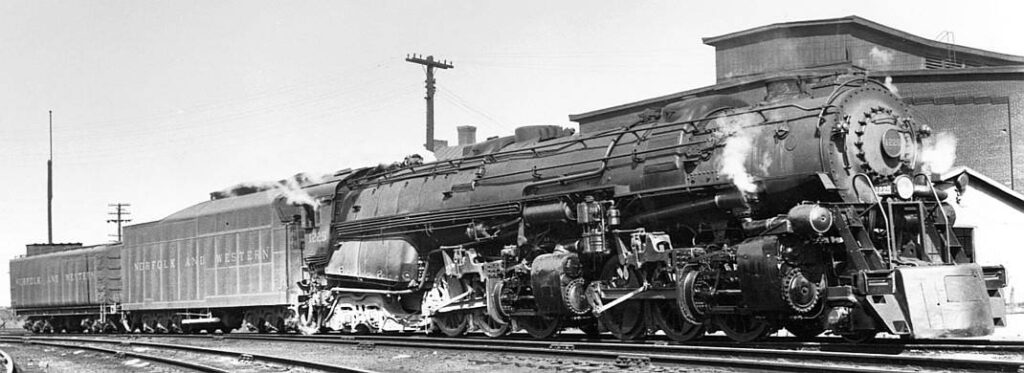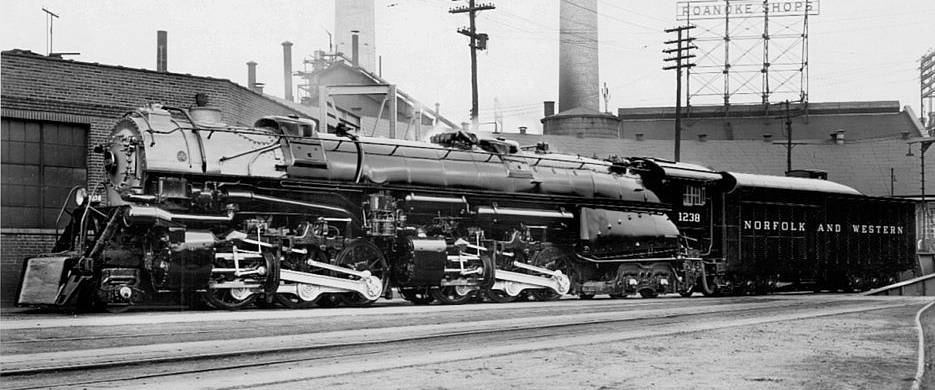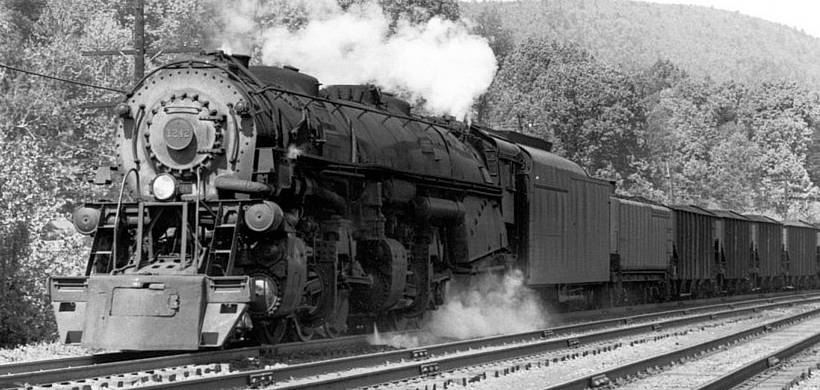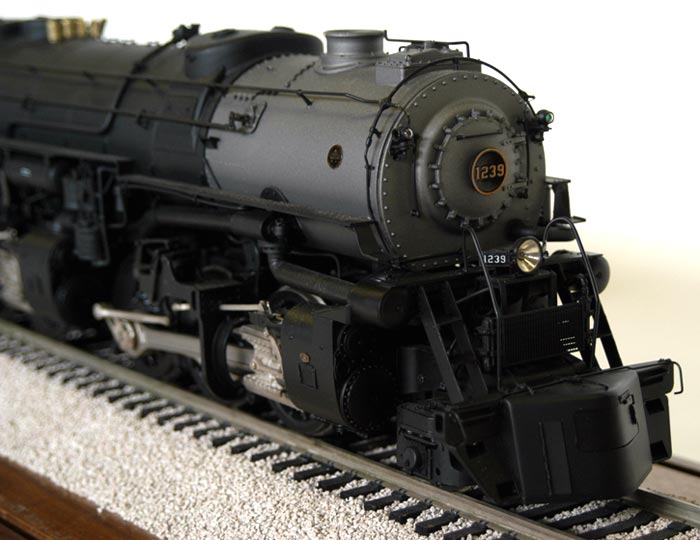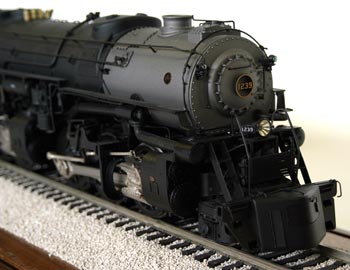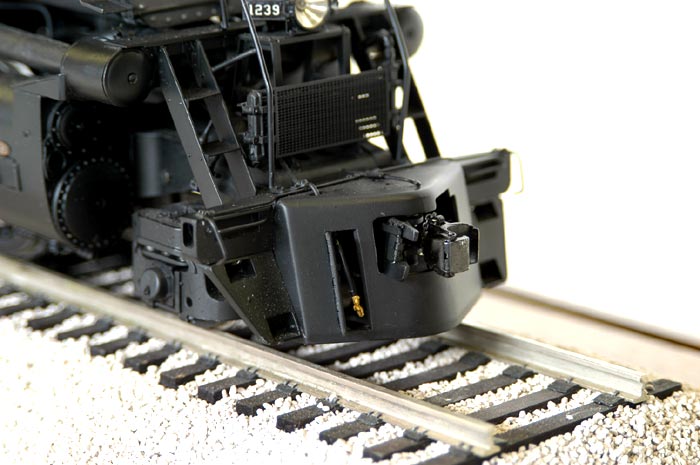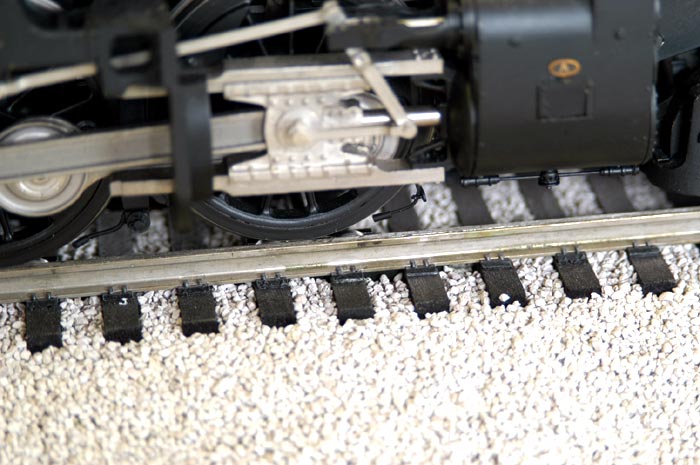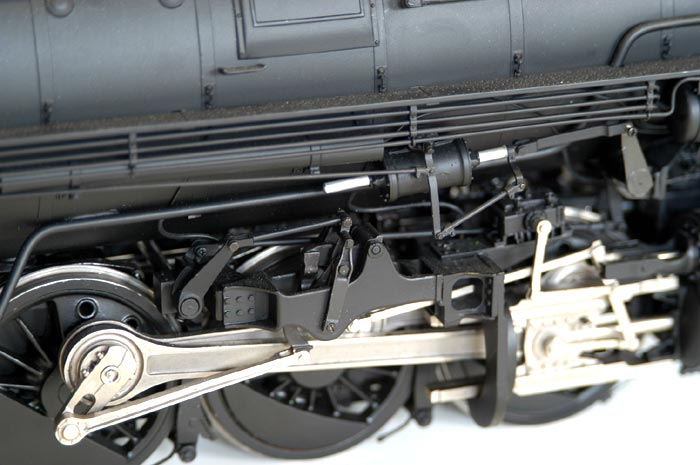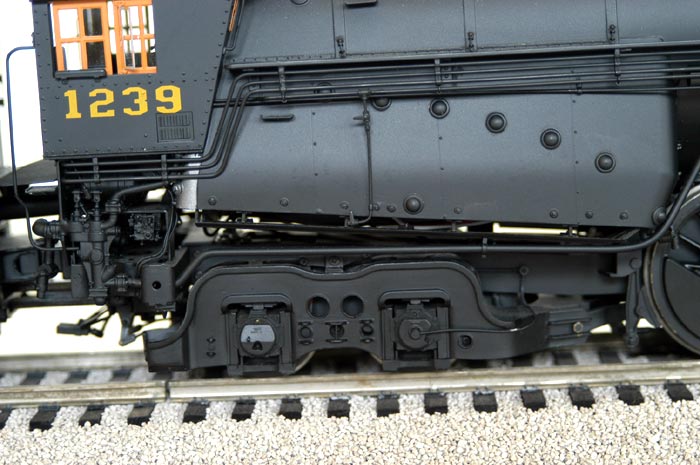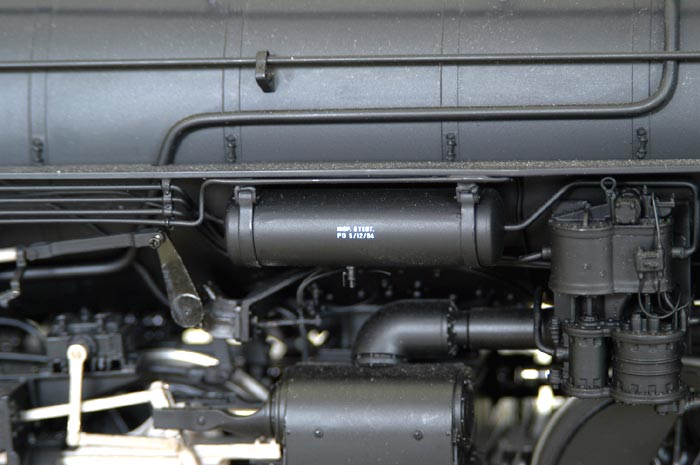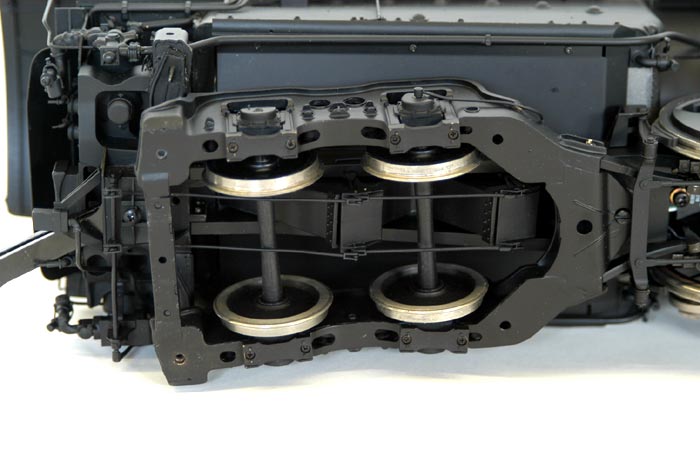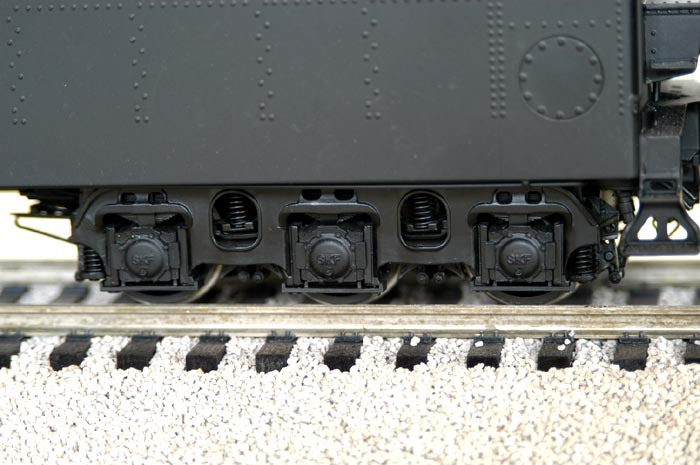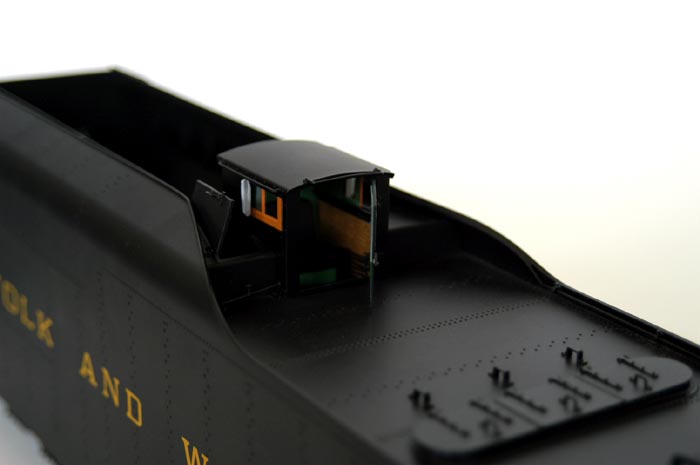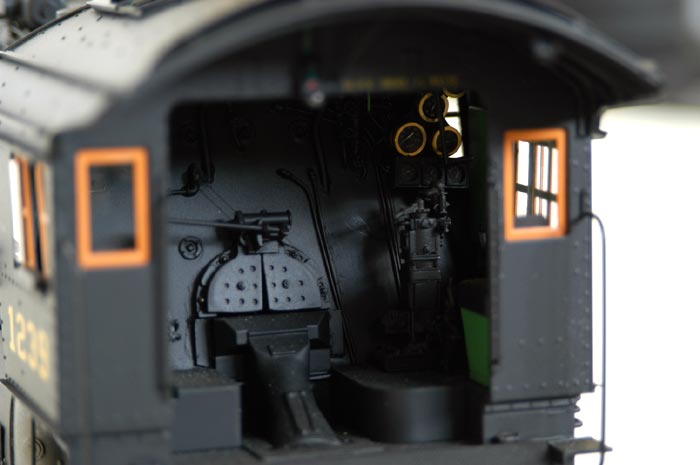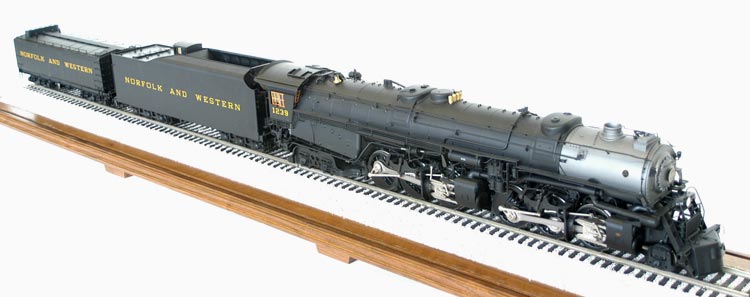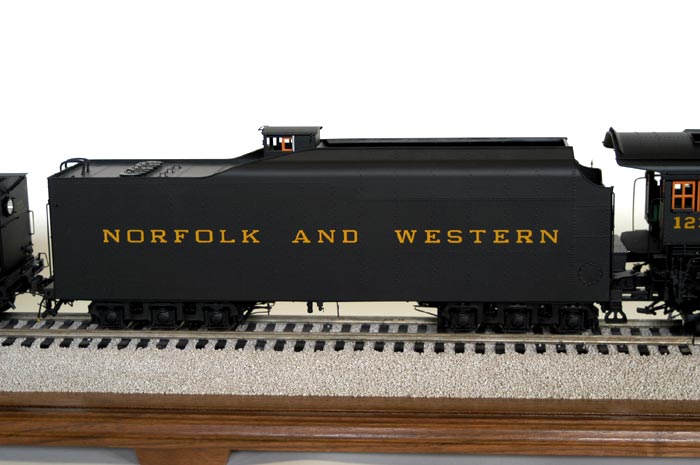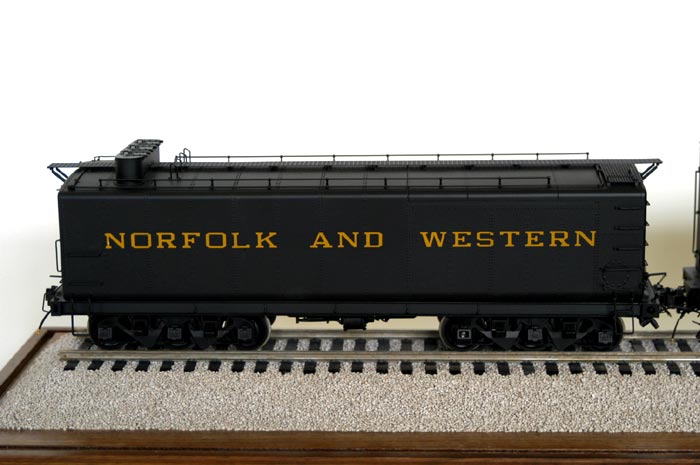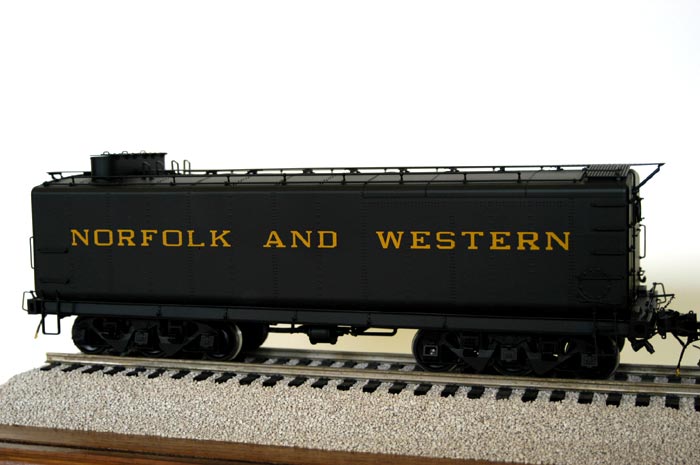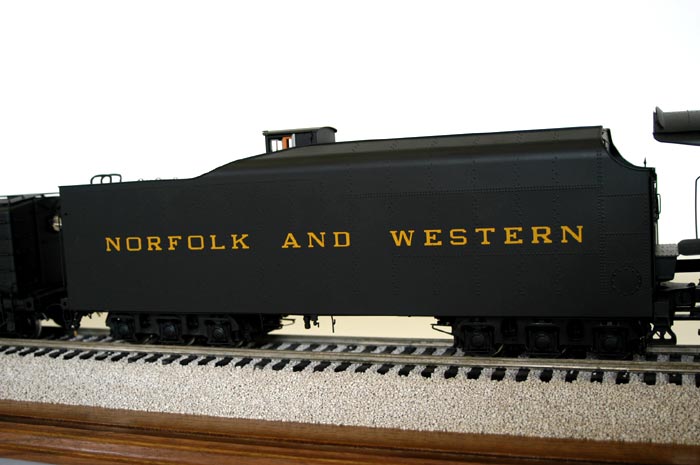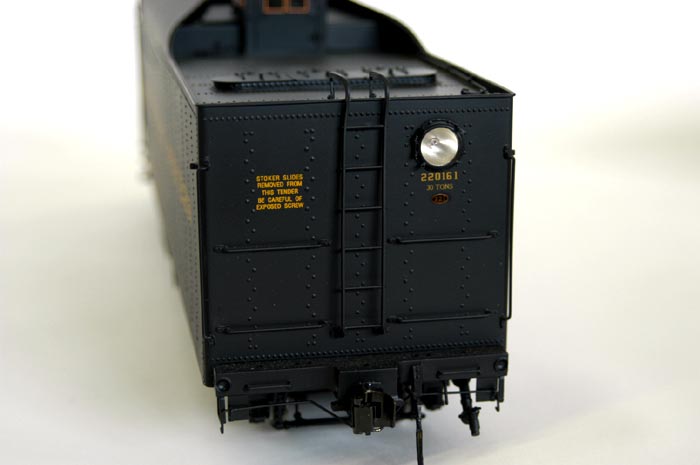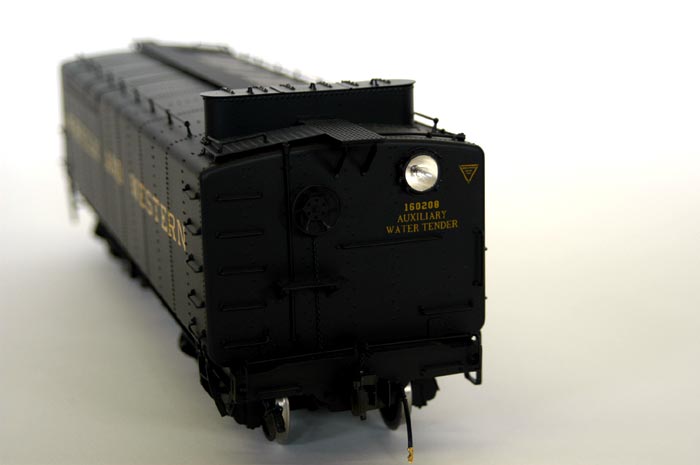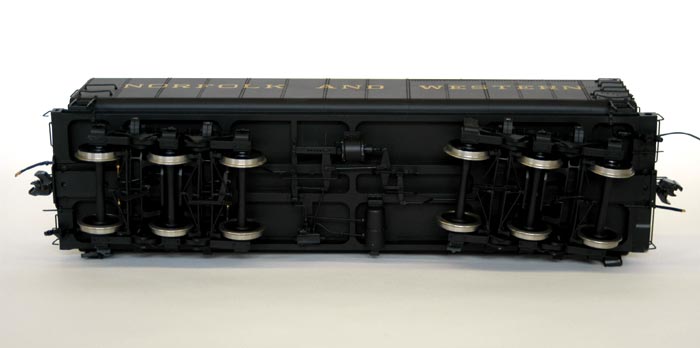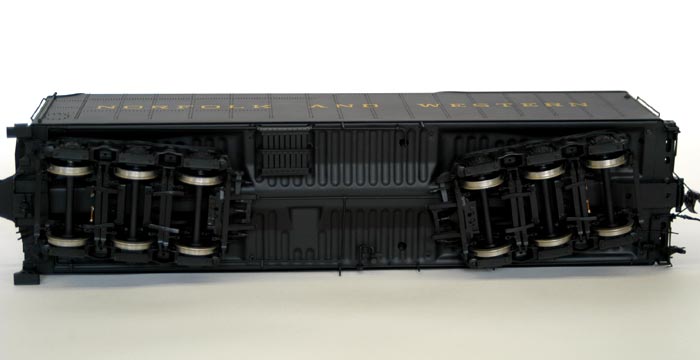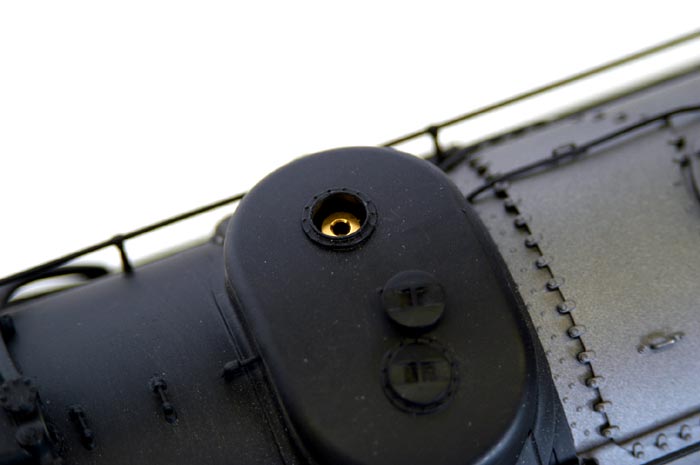Class A
Norfolk & Western – Class A 2-6-6-4
- Scale: 1:32
- Release: 2002
- Limited Edition: 100
- Model Size: 61”L x 5”W x 7”H
- Base Type: Mahogany
- Base/Case Size: 67”L x 11”W x 11”H
- Availability: Sold Out
Norfolk & Western – Class A 2-6-6-4
Among the finest steam power ever used in heavy coal train or high-speed freight service and perhaps, even the finest freight steam locomotives of all, were 43 homemade single-expansion articulateds built, not by a commercial builder, but by the railroad that owned and operated them. So perfectly suited for the conditions under which they ran, that the road continued producing them for fourteen years, until the end of steam. These “thinking man’s articulateds” were known on the Norfolk and Western not by a nickname, but simply as Class A.
The best way to remember the old Norfolk and Western is as a railroad with enlightened management focused on delivering a specialized product—coal—using specialized locomotives under specialized operating conditions. Since World War I, the road had already upgraded many older locomotives, which gave it an opportunity to study their productivity very carefully. When the depression hit, it retained its experience base by shortening workweeks rather than laying off people. But management had already been thinking ahead to a new, higher-capacity locomotive so, as the depression eased in 1934, the design staff set to work on this new project.
They had two important factors in their favor: (1) the N&W’s superlative track and roadbed, which made slipping less likely even for a locomotive with a low factor of adhesion (i.e. relatively low weight for its starting tractive effort); and (2) the availability of high-heat content coal from the Pocahontas fields which, in a firebox of a given size, could maintain steam pressure in a relatively larger boiler. Thus they designed the largest firebox that could be supported by a four-wheel trailing truck and mounted entirely behind the drive wheels, and then mated it to a huge boiler (larger even than the one on the road’s gutsy class Y compound 2-8-8-2s). Twelve large 70-inch drive wheels fit perfectly underneath. Yet their new locomotive was not intended to exceed 70 mph, so it could make do with only a two-wheeled pony (front) truck— hence a 2-6-6-4.
Maintenance considerations also affected their design in many ways. For example: (1) with the pony truck, there was no extra axle inserted behind the front cylinders (as on a 4-6-6-4), so front and rear engines could interchange running gear parts; and (2) while other roads switched from alligator crossheads to single-guide designs (which in many instances had heavy shoes that required two mechanics to remove), the N&W saw that it could better handle high piston thrust by switching back to the alligator arrangement (which, in the bargain) a single mechanic could maintain, working alone.
The designers did their homework well. The resulting Class A locomotive was exceedingly efficient for its 573,000 lb. weight (some 200,000 lbs. less than either the Allegheny or Big Boy designs of 1941, with which its performance has since been compared). Its continuous power curve reached a very high 6325 drawbar horsepower maximum at 40–45 mph, measured at the original boiler pressure of 275 psi, so the N&W used it mainly in bread-and-butter heavy coal service on flat terrain (east from Roanoke to the tidewater terminal at Norfolk and west from Williamson, West Virginia to Columbus, Ohio) where it could cruise at this speed (except for the helper district over the Blue Ridge just east of Roanoke, all the mountainous territory was left to the 2-8-8-2s). Yet the boiler never ran out of steam, even after pressure was raised to 300 psi, so the A also made an exceptional mountain passenger engine (the first two, Nos. 1200 and 1201, were normally assigned to passenger service on the Roanoke, Virginia–Bristol, Virginia-Tennessee run before the advent of the famous Class J streamlined 4-8-4s).
A newcomer’s first impression might be that the As, themselves, were an older design—their smokebox faces had the bald look of an earlier era with no illuminated number boards or even a bell, and their pilot decks were not covered with air pumps, shields or other clutter. But to the educated observer, one who could appreciate their design and performance, they possessed a timeless form-follows-function beauty.
Nos. 1200 and 1201 were out-shopped in 1936 and were quickly followed by eight sisters. Wartime brought 25 more and then, in 1949–50, after all, three major commercial builders had permanently abandoned steam locomotive production, the N&W built a final eight. The last five of these, Nos. 1238–1242, were equipped with Timken lightweight roller-bearing drive rods, the only articulated locomotives ever built with this feature.
Throughout the ’50s, the N&W continued to increase the productivity of its engines. In 1951, for example, studies showed that adding an auxiliary water tender could eliminate the need for some water stops and increase gross ton-miles per train hour (GTM) 31 percent on the 112-mile Kenova District between Williamson and Portsmouth, Ohio. So the railroad rebuilt many older 16,000 gallon tenders for this purpose and increased the As’ tonnage ratings from 13,000 to 14,500 there, and by a comparable amount everywhere else across the system (virtually all photos taken after 1951 show them trailing this auxiliary tender).
One of the last group, No. 1239, was fresh out of the shops in 1952 when the Electro-Motive Division of General Motors came calling with its latest diesel locomotive, seeking to convince the N&W that it should buy their product. In multiple test runs over the same Kenova District, the 1239 matched the diesel in all respects—tonnage, speed, and economy. On one westbound trip with a 175-car train in October of that year, it achieved a whopping 518,700 GTM (i.e. an average of more than 32 mph hauling 16,042 tons). Thus maintained in state-of-the-art condition and having vanquished the diesel once, the As continued as mainline power until they were withdrawn from service en masse in 1958 and 1959. Yet to this day, thanks to the proliferation of photos that show them at their best and renovation of class A No. 1218 for excursion service in the late ’80s and early ’90s, they have retained their reputation as members of the “Elite” of steam.
Fine Art Models
Fine Art Models built the Class A in two versions: the final series with roller-bearing rods, and the wartime locomotives as they appeared with the familiar modifications of the 1950s. Tom Dressler, retired Norfolk and Western (later Norfolk Southern) locomotive engineer, noted modeler, author of numerous articles and publications about N&W steam and a gentleman who made many trips as a pilot engineer on Class A No. 1218 (and class J 4-8-4 No. 611) while they were in excursion service on the NS during the ’80s and ’90s, assisted us with this very ambitious project. We feel our Gauge 1 Norfolk & Western Class A is the most advanced and hi-tech train model ever produced (and will hold this honor for many years to come). Both versions have the solid pilot and large capacity tenders, plus the auxiliary water tenders. The entire set, mounted on a black walnut base with leaded glass cover, runs 61 inches in length (we also plan to offer an N&W steam-era caboose on an extended base), and make an exciting display companion to our Big Boy and Allegheny.
It is difficult to pick a starting point to tell you about this model. It is made of brass, nickel silver, and stainless steel. Every moving part utilizes sealed ball bearings, including the journals on the locomotive, coal tender, and water tender. The locomotive is powered by two 18-volt Pittman motors and runs on 12-volts DC. With two tenders weighing more than forty pounds, the Class A requires just .5 amps to operate – with no hesitation or jerking, even at the lowest power settings.
Every door or hatch on the locomotive and tenders that are supposed to open, does. The front coupler can be extracted from the front pilot and actually used. The sand dome hatches are removable and, when you look in the hatch, you’ll see the boiler rivets – just like the real thing. If you open the smokebox door you’ll see all the detail that is supposed to be there. On the underside of the locomotive, you’ll find everything, including the brakes. Even the ash pans open in the trailing truck! If you look in the brakeman’s house on the coal tender you’ll see the steam radiator with a steam line leading to it from beneath the tender. The models come with re-railing frogs and a complete set of miniature tools. The locomotive and tenders are fully equalized with working suspensions with real coil springs and real leaf springs. The locomotive back head is fully detailed with operating firebox doors and rear lit gauges with the actual dial faces found on the real locomotive. Even the inspection door on the floor of the cab opens.
Sound System
The best part of this model is the sound system and the fact that the model is fully digitized. We took the sound of the real locomotive, complete with whistle and bell, and programmed it into a computer chip. We have infrared eyes reading a cam on the two sets of locomotive drive wheels so the chuffs are fully synchronized. We have a servo that operates the reversing gear when the direction is changed. Every sound heard on the real locomotive is on our model including air compressors, dynamo, steam blow-off, steam exhaust, and even the sound of brakes as the locomotive slows from speed. Programmed into the computer chip is the sound of water filling the water tender and coal being loaded into the coal tender. These sounds are operated by the engineer along with the bell and whistle. There is even a feature that allows the chuff to be changed from light to heavy, based on the size of the train being pulled.
There are no batteries and no lines to plug in between the locomotive and tenders. Everything is housed in the locomotive. And everything is controlled by remote control. All the lights on the locomotive and tenders can be turned off and on individually. The sound system volume can be regulated with buttons found in the rear sand dome. And, if you are so inclined, we can supply a computer cable and software so you can plug into the front sand dome and program your computer chip to suit yourself.
The model comes with a power supply compatible with both 110V and 220V. It also comes with a black walnut base with hand laid nickel silver rail and real wood ties and leaded glass case to protect the model fro dust when not in use. The track is ballasted with the correct color ballast. But the best feature of this package is the high-tech roller base built into the track. It allows the locomotive to appear sitting on the rails when actually the drive wheel flanges are sitting on a set of roller bearings, which puts the tire of the drive .5mm off the top of the rail. You plug the digitized power supply into the base and you can run your locomotive in place (you can also run any Gauge 1 locomotive with six drive wheels or less on this system by merely sliding the bearings to the correct location).
We built a total of one hundred of these models and, due to the rising costs, doubt that we will ever again build a locomotive of this size. As a result, we doubt you’ll ever again see a model of this magnitude and quality in your lifetime.
